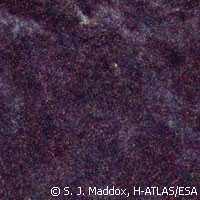New way of finding cosmic lenses facilitates study of distant galaxies
A European team of astronomers has discovered a new way of finding cosmic zoom lenses, which allow astronomers to peer at galaxies in the distant universe. The ability to study galaxies - that were until now deemed too far away to investigate - will provide key insights into how galaxies have changed over the history of the cosmos, according to the researchers. The results, taken from the very first data revealed by the European Space Agency's Herschel-ATLAS (Astrophysical Terahertz Large Area Survey) project, were recently published in the journal Science. The cosmic lenses were discovered by the European Space Agency's (ESA) Herschel Space Observatory that looks at far-infrared light emitted not by stars, but by the gas and dust from which they form. Dr Mattia Negrello from the UK's Open University and lead researcher of the study said: 'Our survey of the sky looks for sources of sub-millimetre light. The big breakthrough is that we have discovered that many of the brightest sources are being magnified by lenses, which means that we no longer have to rely on the rather inefficient methods of finding lenses which are used at visible and radio wavelengths.' The Herschel-ATLAS images contain thousands of galaxies, most so far away that the light has taken billions of years to reach us. Dr Negrello and his team investigated five surprisingly bright objects in a small patch of sky. By looking at the positions of these bright objects with optical telescopes on the Earth, they found galaxies that would not normally be bright at the far-infrared wavelengths observed by Herschel. This led them to suspect that the galaxies seen in visible light might be gravitational lenses magnifying much more distant galaxies seen by Herschel. Dr David Bonfield from the University of Hertfordshire in the UK used visible and near-infrared measurements taken from existing visible images to estimate the distances to the galaxies believed to be acting as lenses. 'More distant galaxies have their light stretched to longer, redder wavelengths, because the light travels through more of the expanding universe before reaching us,' he explained. 'So we can use the colours they appear to figure out how far away they are.' To find the true distances to the Herschel sources behind the lenses, Dr Negrello and his team looked for a tell-tale signature of molecular gas. Using radio and sub-millimetre telescopes on the ground, they showed that this signature implies that the galaxies are being seen as they were when the universe was between only 2 and 4 billion years old, less than a third of its current age. The galaxies seen by the optical telescopes are much closer, each ideally positioned to create a gravitational lens. 'Previous searches for magnified galaxies have targeted clusters of galaxies where the huge mass of the cluster makes the gravitational lensing effect unavoidable,' said Dr Negrello. 'Our results show that gravitational lensing is at work in not just a few, but in all of the distant and bright galaxies seen by Herschel.' Astronomers at the University of Hertfordshire said there would be 'many more exciting results to come' as the survey continues. The Herschel ATLAS project was awarded 600 hours of Herschel observation time to survey 550 square degrees of sky. It is expected to detect approximately 250,000 galaxies, from the nearby universe out to more distant galaxies when the universe was only around 2 billion years old. The Herschel space observatory was launched in May 2009 and, according to researchers, is now in a routine science phase. It will continue observing until its liquid helium coolant runs out in around 2.5 years. Last year, TIME Magazine voted Herschel the seventh best invention of 2009.
Countries
United Kingdom



